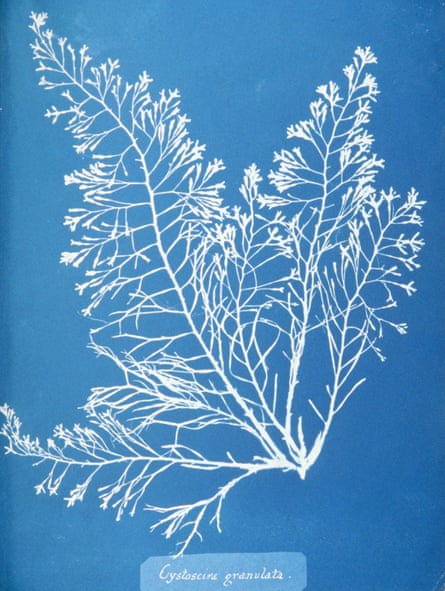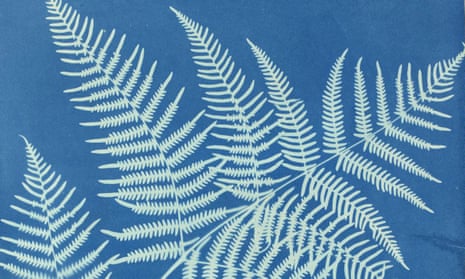‘Photography pioneer” conjures up an image of a Victorian gentleman under a drape with an outsize wooden box on a tripod. Yet one of the biggest landmark moments of early photography was down to a woman who didn’t even use a camera, and was born decades before Victoria became queen.
Anna Atkins is considered to have been the first female photographer. She was born in Kent in 1799, and she made her most significant contribution across 10 years in the mid-19th century in which she created at least 10,000 images by hand. But it was what she did with those pictures that gave her a place in art history. Atkins realised what millions of social media users know today: that images are for sharing. She created the first book to contain photographs, and she paved the way for photography’s power to connect people.
Atkins’s book is the highlight of a major retrospective of 19th-century photography at the Rijksmuseum in Amsterdam this summer. It shines a light on an artist whose legacy was, like that of so many women who played their part in the creation of art, woefully overlooked for many years. Dr Hans Rooseboom, curator of photography at the museum, says it was not until the 1970s – more than a century after her death – that art historians uncovered her role. “Until then, the history of photography, and particularly the contribution of Atkins, had received very little attention.”
Atkins’s most important early influence was her father, John George Children. The two were particularly close, thrown together when Anna’s mother, Hester, died a few months after her only child’s birth. A highly respected scientist who was secretary of the Royal Society in 1826 and again between 1830-37, Children was unusual in his time for his belief that a daughter could do whatever a son could do, and he fostered her interest in botany.
But it was his contacts that helped his daughter the most. In February 1839 he was present at a Royal Society meeting at which a Wiltshire landowner, William Henry Fox Talbot, outlined his exciting new invention – the creation of “photograms”, that used chemicals and sunlight to create images on paper, and led to the development of camera-made images. Anna’s fascination with nature had seen her drawing shells and plants laboriously by hand to record them accurately; the implications of this new way of producing images were not lost on Children, who hurried home to share what he had heard. A few months later, Children wrote to Talbot that “my daughter and I shall set to work in good earnest ’till we completely succeed in practising your invaluable process”.
Anna – who had married a railway promoter called John Pelly Atkins in 1825 – was later influenced by another photography pioneer: Sir John Herschel. In 1842 Herschel sent Children a copy of his paper describing his refinement of Talbot’s process, an invention he called the cyanotype, involving two chemical compounds, ammonium ferric citrate and potassium ferricyanide, which were applied to a sheet of paper with a brush. The paper was dried, and a flat object was then laid on top of it, and left in sunlight. Once it had been exposed to enough light, the paper was washed in water, but the image of the object remained.

It was Atkins’s interest in the study of algae that prompted her book. She was so disappointed by the lack of illustrations in a guide to British algae published in 1841 that she decided to do something about it. In the autumn of 1843 she began work on creating images of hundreds of different types, using Herschel’s cyanotype method. It was a meticulous task whose skill rested in working quickly to assemble the dried algae arrangement, before leaving the paper exposed to sunlight for precisely the right amount of time.
Looking at Atkins’s book today, what is most striking is not the outlines of the algae, however beautifully and delicately they crawl across the pages; it is the glorious depth of the Prussian blue backdrop to the images. The Herschel method dyed the paper, resulting in every page of the book being a deep blue with the algae outlines in cream. (A byproduct of the process was the addition of the word “blueprint” to the English language.)
The images are surprisingly modern-looking: here a seahorse-like shape dominating the page, there a spiky snowflake. Elsewhere, feathery outlines and ghostly wisps of plant life. Some of the pages have just one or two tiny blobs of algae, others what appear to be arrangements of material, displayed with an aesthetic as well as a scientific eye. “We can tell that Atkins was very conscientious, and also proficient,” says Rooseboom. “She used very good quality paper, which is why the images are in such excellent condition to this day, and she became adept at judging the time the paper needed in sunlight, so the images are as clear as possible. Given that we are 170 years on, they are remarkably fresh, and artists today still use this process to create their work.”

Every one of the 307 images in the Rijksmuseum’s copy of the book was produced by hand by Atkins, since each of the 12 or so copies of her book was a bespoke production. Her work predated by several decades the technology that would later allow photography to be mass reproduced but, true to the instinct that photography was for sharing, she worked for 10 years to create enough images to be bound into volumes by her colleagues and contacts. She sent her images to them, each annotated with the Latin name of the plant in her small, precise handwriting.
Shortly before her algae project was finished, Atkins’s father died and she embarked on writing his biography before switching her botanic interest to ferns. She donated her herbarium to the British Museum in 1865 and died six years later, in 1871.
Although she will be remembered for her hand-produced photographs, Atkins did own a camera: in a letter to Talbot after his presentation at the Royal Society, Children noted: “I have ordered a camera for Mrs Atkins from Ross.” Given everything she knew about photography, there is every reason to assume that she made good use of it, but sadly for art history, none of her camera photographs have survived.

Comments (…)
Sign in or create your Guardian account to join the discussion